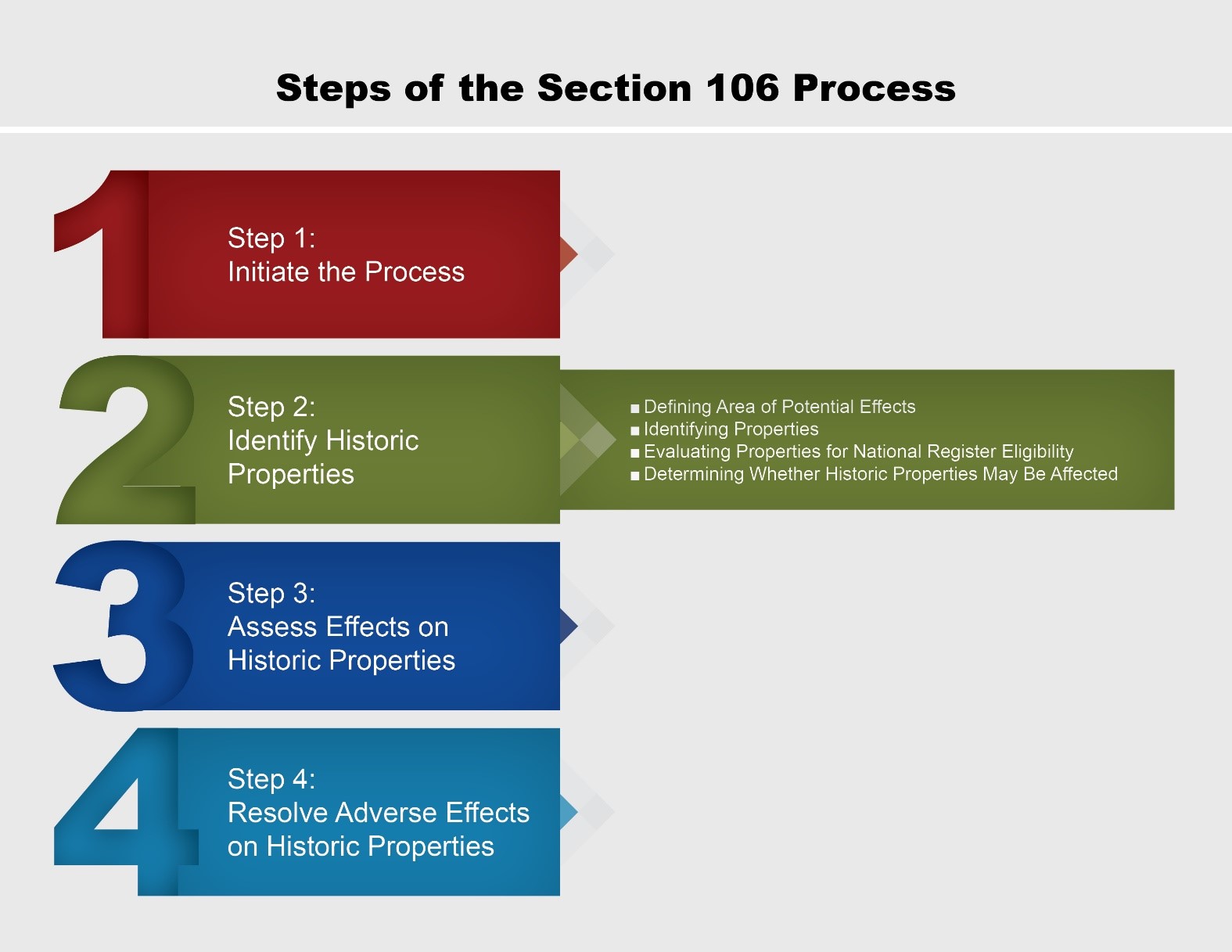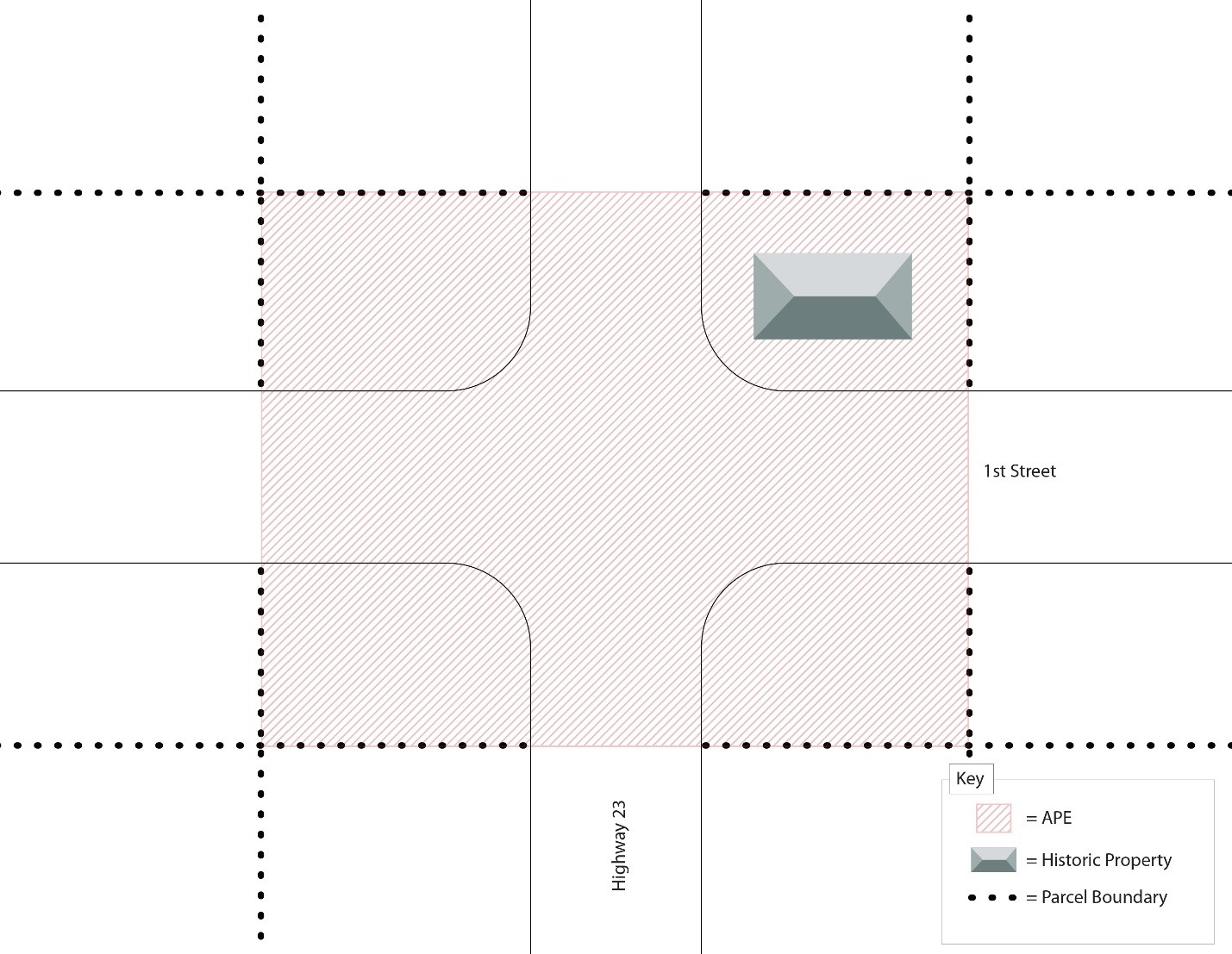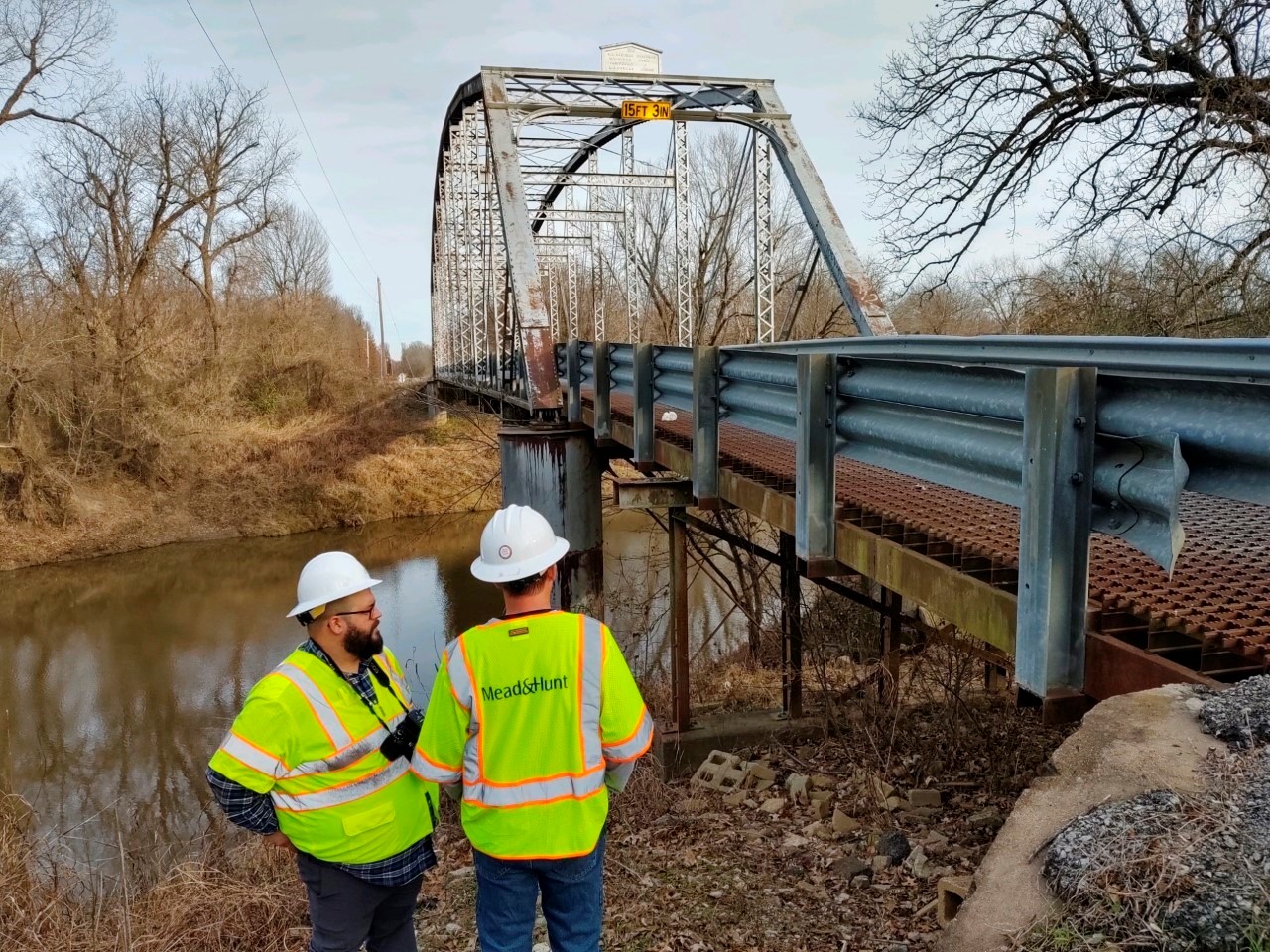Steps of the Section 106 Process
STEP 2: IDENTIFYING HISTORIC PROPERTIES

Step 2 of the Section 106 process is to identify historic properties. See full description here.
The second step of the Section 106 process is to determine whether any historic properties could be affected by the project or approval under consideration (i.e., the undertaking). FHWA is responsible for making a reasonable and good faith effort to identify historic properties that may be affected by an undertaking. There are two aspects to this identification step:
- Are there any historic properties within the geographic area that could be affected by the undertaking?
- If there are historic properties present, could they be affected by the project?
While FHWA may rely on work conducted by applicants (e.g., State DOTs or Local Public Agencies [LPAs]) and/or their consultants with qualified professionals to inform decision-making, FHWA remains responsible for identifying historic properties unless there is a formal agreement that delegates this decision to the State DOT.
To address the first question noted above, FHWA will:
- Define the Area of Potential Effects (APE)
- Determine the appropriate level of effort to identify historic properties in the APE
- Carry out necessary studies to identify historic properties (including identifying the presence of properties already listed in the National Register of Historic Places [National Register])
- Evaluate whether any newly identified properties are National Register-eligible
- Determine whether National Register-listed or eligible historic properties may be affected by the undertaking
Defining the APE
The first part of this step requires FHWA, in consultation with the appropriate SHPO/THPO, to define the geographic area where a project may have an effect on historic properties, if present.
The APE is the geographic area or areas within which an undertaking may directly or indirectly cause alterations in the character or use of historic properties. This definition is made prospectively, meaning it is not necessary to know beforehand whether there are historic properties in the area. In defining the APE, all potential effects of the project should be considered. These include direct physical damage, destruction, or alterations to properties, or relocating or moving a property. When defining an APE, FHWA must also consider any indirect impacts such as change of a property’s historic use or changes to the physical features of its setting. Indirect effects could include introduction of visual elements that are out of character with a property’s environment when setting is a significant feature of the property. Increased noise is another form of indirect impact when a quiet environment is a character-defining feature of a property. Atmospheric elements, such as emissions, are another form of indirect impact that could alter the setting of a historic property.

An example of an APE map showing one historic property in a project APE.
The scale of the APE is influenced by the scale and nature of the project, but because the APE includes indirect impacts it is almost always larger than the project area or right-of-way. The APE may also be different for different kinds of historic properties. For example, properties below ground (i.e., archeological sites) would not be subject to noise and visual impacts as would properties above ground, like a historic home. Therefore, the APE for belowground resources might be considerably smaller than the APE for aboveground resources (e.g., buildings and structures). The APE may also have a vertical element; for example, areas planned for excavation may need consideration for belowground properties (e.g., archeological sites). The height of a planned project should also be considered in defining the APE, as a tall overpass, bridge, or parking structure means a greater area in which it may have a visual impact.

The height of project activities should be accounted for in the APE, such as this overpass shown here in a historic district in El Paso, Texas. Photograph courtesy of the Texas Department of Transportation.
Definition of the APE is a critical project decision and should be made in consultation with SHPO/THPO to ensure the area defined is reasonable given the project, what may be known about the area, and the types of historic properties that could be expected there. The APE defines where you will look for historic properties, but a large APE does not require every part of the APE to be surveyed at the same level or in the same manner. How you will look, using different methods and levels of effort within the APE, will depend on the types of historic properties that may be present. Archeological investigations will be limited to those areas where ground disturbance is reasonably foreseeable, while survey to identify historic buildings will encompass areas that will be physically affected as well as more expansive areas that include possible indirect effects. It is always possible to refine the size of the APE as a project changes and/or alternatives narrow, but if an initial APE is too small it may result in substantial delays as new historic property surveys are undertaken. Defining the APE is the foundation for sound and timely decision-making since late surprises may upset not just the Section 106 process, but also the related NEPA and Section 4(f) processes, delaying project approval. Accordingly, casting a wide net when initially defining the APE is usually recommended.
Identifying Properties
Once the APE is defined, the next stage of Step 2 involves determining the level of effort that will be necessary to identify properties in the APE that might have historic significance. This involves assessing what may already be known about the area, whether there are historic properties already listed in the National Register, and whether new research and survey work needs to be undertaken to identify additional historic properties. This assessment should be made in consultation with SHPO/THPO and other consulting parties who may have information and practical suggestions that will facilitate the identification process. Similarly, the process should seek information from any individuals or organizations likely to have information about or concerns with historic properties in the area, such as local historical societies or “Save Our Bridge” organizations. It is important to remember that at this stage, you should be relying on the expertise of qualified professionals for research on the relevant historic contexts for the APE and any new survey work that may be needed to complete identification efforts.

Identification efforts should include assessing what may already be known about the area. Taliesin in Spring Green, Wisconsin, a National Historic Landmark, was previously identified as a historic property and was in the APE for a Wisconsin DOT project. Photograph courtesy of Mead & Hunt.
It may be necessary to conduct new or additional survey work within an APE to identify historic properties that have not previously been evaluated for National Register eligibility. Any substantial identification effort may have an impact on the project schedule.
Understanding the extent of the needed identification effort will be necessary to allow adequate time to identify these properties and complete the Section 106 process prior to project approval. While FHWA does not normally carry out the investigations itself, FHWA Division Office staff should be informed consumers of the information gathered. FHWA should ensure that the work is carried out by agency personnel or qualified professionals and that the level of effort is adequate to identify historic properties and their character-defining features.
Given that Tribes possess special expertise regarding properties of religious and cultural significance to them, include efforts to engage Tribes in the identification process as well. This applies to all parts of the APE on or off tribal lands. Tribes may raise concerns about the confidentiality of any information they supply in this process. It is generally recommended that sensitive information such as location or the nature of such properties be routinely withheld from public documentation. See Additional Information in Section 106 Participants: Roles and Responsibilities for more information on confidentiality.
As stated in the Section 106 regulations, FHWA is required to make a “reasonable and good faith effort” to identify historic properties that may be affected by agency actions. It is up to the agency to determine what is a “reasonable and good faith effort”; however as noted earlier, FHWA should consult with SHPO/THPO and other consulting parties who may have information and practical suggestions that will facilitate the process of identification. In addition, FHWA can use SHPO and State DOT archaeological and historic architecture/structure survey guidelines to inform the level of effort for investigations within an APE.
The Advisory Council on Historic Preservation’s (ACHP’s) guidance on the “reasonable and good faith effort” standard states that a SHPO/THPO or other consulting party does not have to approve FHWA’s identification effort. SHPO/THPO and other consulting parties advise and assist FHWA in developing its identification efforts, but do not dictate its scope or intensity. In addition, the identification of every historic property within an APE is not required. Further, the Section 106 process does not require FHWA to look outside the boundaries of a project’s APE.

Field work is conducted to identify historic properties along a transportation project corridor in Texas. Photograph courtesy of Mead & Hunt.
A phased approach to identification may be used for projects with large land areas or multiple corridors, or where access to properties is restricted. Final identification, evaluation, and treatment of historic properties may be deferred in such cases, if it is specifically provided for in a Memorandum of Agreement (MOA) or project PA executed among the agency, SHPO/THPO, and other participating parties. In the case of deferred (or phased) identification, the process stipulated in the MOA/PA should establish the likely presence of historic properties for each alternative under consideration and set up a protocol for final identification, evaluation, and consultation to resolve any adverse effects.
It should be noted there are cases where state laws require a State DOT and consultants with qualified professionals to obtain a state permit in order to conduct investigations, particularly for archeology. These permits often require adherence to SHPO’s or another state agency’s archeological or other relevant survey guidelines or standards. The State DOT’s or the consultant’s work by qualified professionals will be rejected by the state agency reviewing the reports if these guidelines or standards are not followed. In these cases, it is important these investigations are conducted by qualified professionals who understand or are experienced in the application of state guidelines or standards.
Evaluating Properties for National Register Eligibility
The responsibility for determining whether a property identified within the APE is eligible for the National Register lies with FHWA, but such a determination is not a unilateral decision. FHWA is charged with applying the National Register Criteria for Evaluation, in consultation with SHPO/THPO and any Tribe(s) that attaches religious and cultural significance to the property. Properties that have been previously evaluated for the National Register or are already listed may have to be revisited as part of the identification effort to assess changes that occur over time to their physical condition, new research, or changing perceptions of what is historically significant.
In practice, recommendations regarding eligibility are usually made on a property-by-property basis to FHWA by professionally qualified staff of the State DOT or their consultants with qualified professionals based on information gathered for each property in the APE with the potential for historic significance. FHWA staff, however, should be familiar with the National Register Criteria for Evaluation in order to understand the basis for recommendations they receive and be able to accept the findings on behalf of FHWA.
As noted, the formal determination of eligibility is made on a property-by-property basis. If at least one of the four National Register criteria is met and the property retains adequate integrity to convey its significance, and SHPO/THPO agrees, the property is considered eligible for the National Register. If FHWA makes a determination that a property is not eligible and SHPO/THPO does not agree (or if the ACHP or the Secretary of the Interior requests), FHWA will submit a request for a formal finding on National Register eligibility from the Keeper of the National Register (Keeper). The request must be supported by adequate documentation to explain the basis for the original finding, and therefore may require more documentation be produced and submitted to the Keeper.
The Keeper has 45 days after the receipt of adequate documentation to make their finding with the outcome binding on the agency, so it behooves the agency to keep a dialogue open with all the interested parties. Any consulting party, particularly a Tribe that attaches religious and cultural significance to a property off tribal land, or a member of the public, may request that the ACHP step into the process if they do not agree with the agency’s finding regarding National Register eligibility. This is another reason to involve consulting parties in a meaningful manner early in the process to ensure you are aware of their concerns and perspectives.
Determining Whether Historic Properties May Be Affected
If the agency finds either that there are no historic properties present in the APE or there are historic properties present but the project will have no effect on them, FHWA makes a Section 106 finding of No Historic Properties Affected. An “effect” as defined in the regulations means, “…alteration to the characteristics of a historic property qualifying it for inclusion in or eligibility for the National Register.” FHWA submits this finding formally to SHPO/THPO with specific supporting documentation (see 36 CFR Part 800.11(d) for documentation standards), notifies all other consulting parties, and makes the documentation available for public inspection, keeping in mind that sensitive information should be withheld pursuant to statutory and regulatory provisions for confidentiality. SHPO/THPO and ACHP (if it has chosen to participate) has 30 days from receipt of the finding and supporting documentation to object to the finding. If none of the consulting parties has raised an objection during this period, FHWA will have fulfilled its Section 106 obligations and may approve the undertaking.
If SHPO/THPO objects to the finding of No Historic Properties Affected, FHWA will consult with the objecting party to resolve the disagreement. If an impasse is reached, FHWA may request that the ACHP review the finding. The ACHP may also choose to object to the finding and provide its own opinion; this rarely happens but is governed by the process laid out in the regulations (36 CFR Part 800.4(d)iii and iv). If SHPO/THPO and/or the ACHP object, FHWA takes the objection into account and can still proceed with the agency’s original finding of No Historic Properties Affected and approve the undertaking. FHWA should also document how it considered the SHPO/THPO and/or ACHP objection.
Evaluating if Historic Properties are Affected
If historic properties identified in the APE may be affected by FHWA’s project, FHWA notifies SHPO/THPO and other consulting parties (and the ACHP if it is participating). FHWA’s notification carries the Section 106 review process forward to the next step and seeks the views of the consulting parties in assessing if the properties will be adversely affected by FHWA’s project.
For questions or feedback on this subject matter content, please contact David Clarke.

